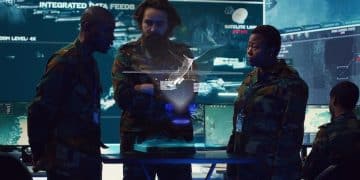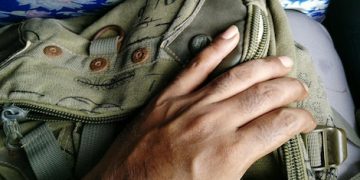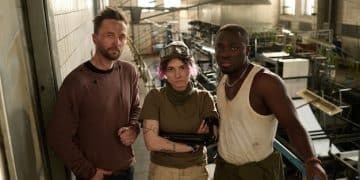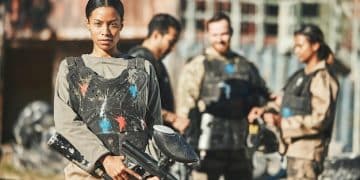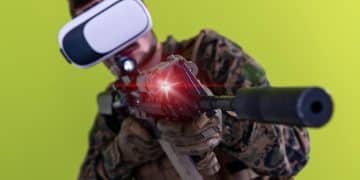Military Art in 2025: Reflecting the Future of War
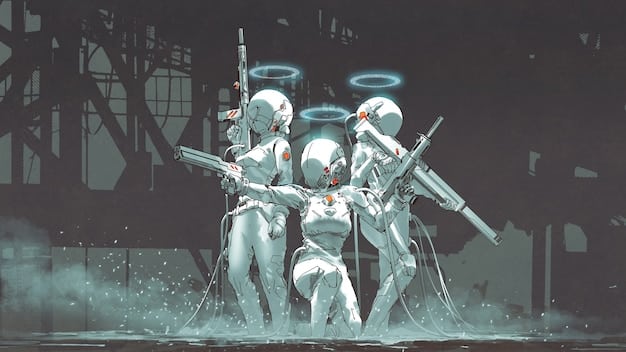
Military art in 2025 will likely reflect the increased use of technology, psychological aspects of warfare, and the evolving roles of soldiers, incorporating augmented reality and interactive installations to explore the complex realities of modern conflicts.
How will military art evolve to reflect the brutal realities of war in 2025? With rapid technological advancements and shifting geopolitical landscapes, the nature of conflict is constantly changing. Military art, traditionally a medium for propaganda, documentation, and commemoration, must adapt to capture the multifaceted experiences of modern warfare. This article explores how artists might use emerging technologies, address psychological warfare, and depict the evolving roles of soldiers, ultimately reshaping the way we understand and engage with war.
The Role of Technology in Shaping Military Art
Technology is rapidly transforming both the battlefield and the artistic landscape. In 2025, military art will increasingly incorporate digital mediums to capture the complexities and nuances of modern warfare, moving beyond traditional portrayals of heroism and valor.
The integration of technology will allow artists to create immersive and interactive experiences that engage viewers on a deeper level, fostering a more profound understanding of the realities faced by soldiers in the field.
Augmented Reality and Interactive Installations
Augmented reality (AR) and interactive installations offer powerful tools for military artists to create impactful works. These technologies enable viewers to engage directly with the art, enhancing their understanding of the subject matter.
Imagine an AR installation that overlays a modern battlefield onto a physical space, allowing viewers to experience the chaos and disorientiation of combat firsthand.
- AR Overlays: Superimpose digital information onto real-world environments.
- Interactive Installations: Allow viewers to manipulate and engage with the artwork.
- Virtual Reality Experiences: Immerse viewers in simulated combat scenarios.
- Data Visualization: Use data from battlefields to create abstract art representations.
The use of these technologies can challenge traditional notions of art and create more meaningful connections between viewers and the realities of war.
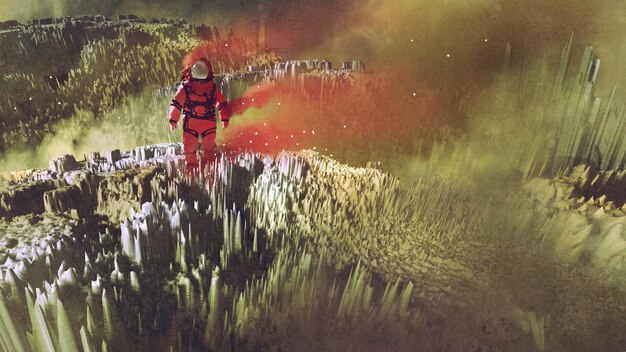
The Psychological Impact of Modern Warfare
Modern warfare takes a significant psychological toll on soldiers. Military art in 2025 will likely focus more on depicting these unseen wounds, exploring the mental and emotional challenges faced by those who serve.
By addressing these psychological aspects, artists can help raise awareness and reduce the stigma surrounding mental health issues within the military community.
Representing Trauma and PTSD
Trauma and post-traumatic stress disorder (PTSD) are significant concerns for veterans. Art can serve as a powerful medium for expressing these experiences.
Artists might use abstract forms, dissonant colors, and fractured compositions to convey the fragmented memories and emotional turmoil associated with PTSD.
- Abstract Expressionism: Convey intense emotions through non-representational forms.
- Surrealism: Explore the subconscious mind and dreamlike states.
- Documentary Photography: Capture raw and unfiltered images of veterans struggling with PTSD.
- Performance Art: Use the body to express the physical and emotional pain of trauma.
Such artistic representations can offer a voice to those who struggle to articulate their experiences, fostering empathy and understanding.
Depicting the Evolving Roles of Soldiers
The roles of soldiers are constantly evolving with advancements in technology and changes in military strategy. Military art in 2025 must reflect these shifts, moving beyond traditional depictions of combat heroism.
Artists will need to capture the complexities of modern military service, including the use of drones, cyber warfare, and peacekeeping operations.
Beyond Traditional Combat Roles
Modern military service encompasses a wide range of roles beyond traditional combat. Artists can explore these diverse experiences through their work.
Consider a series of portraits depicting soldiers working as drone operators, cyber security specialists, or humanitarian aid workers. These representations can broaden our understanding of what it means to serve in the military today.
- Drone Warfare: Depict the remote and detached nature of drone combat.
- Cyber Warfare: Explore the intangible and psychological aspects of online battles.
- Peacekeeping Operations: Highlight the complex challenges of maintaining peace in conflict zones.
- Humanitarian Aid: Showcase the compassionate side of military service.
By showcasing these evolving roles, military art can help to redefine our perceptions of soldiers and their contributions.
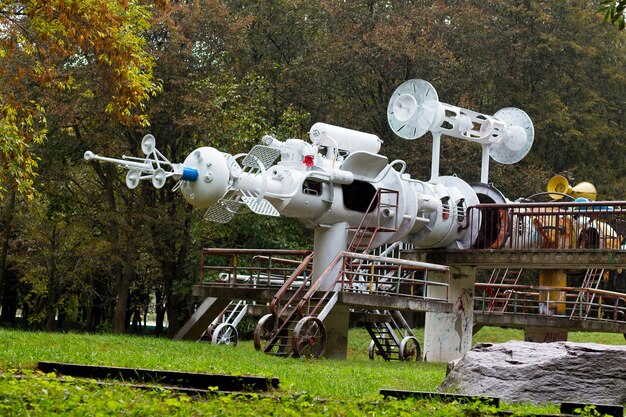
The Ethical Considerations of Military Art
Military art often grapples with ethical considerations, particularly regarding the glorification of war and the potential for propaganda. In an era of increasingly complex conflicts, it is essential for artists to approach these themes with sensitivity and critical awareness.
In 2025, military art must challenge viewers to consider the moral implications of warfare and the responsibilities of individuals and nations.
Addressing Propaganda and Glorification
Historically, military art has been used to promote nationalist agendas and glorify war. Artists must be aware of this history and strive to create works that offer a nuanced and critical perspective.
One approach is to subvert traditional heroic imagery, highlighting the suffering and devastation caused by conflict. Another is to explore the perspectives of marginalized groups affected by war, such as refugees and civilians.
The Artist’s Responsibility
Artists have a responsibility to use their work to promote peace and understanding, rather than simply glorifying violence. This requires careful consideration of the message being conveyed and the potential impact on viewers.
It’s important for artists to collaborate with veterans and other stakeholders to ensure that their work accurately reflects the realities of war and respects the experiences of those who have been affected by it.
The Impact of AI and Machine Learning on Military Art
Artificial intelligence (AI) and machine learning are transforming many aspects of our lives, including the art world. In 2025, AI may be used to create military art, raising new questions about authorship, creativity, and the role of human emotion in artistic expression.
While AI-generated art may offer new possibilities for exploring the complexities of war, it is essential to consider the ethical implications and ensure that human perspectives remain at the forefront.
AI as a Tool for Creative Exploration
AI can be used as a tool to assist artists in creating military art, generating new forms, patterns, and compositions. This can open up new avenues for creative exploration and challenge traditional artistic conventions.
However, it is important to remember that AI is ultimately a tool, and the human artist must retain control over the creative process to ensure that the work reflects their vision and values.
The Future of Military Museums and Exhibitions
Military museums and exhibitions play a crucial role in preserving and interpreting the history of warfare. In 2025, these institutions will need to adapt to changing technologies and engage with new audiences in innovative ways.
By incorporating interactive exhibits, digital archives, and virtual reality experiences, military museums can create more immersive and engaging learning environments that promote a deeper understanding of the realities of war.
Creating Immersive and Engaging Experiences
Military museums can use technology to create immersive and engaging experiences that bring history to life. For example, visitors could use VR headsets to experience what it was like to be a soldier in a particular battle.
- Virtual Reality Tours: Allow visitors to explore historical battlefields.
- Interactive Exhibits: Engage visitors with hands-on displays and simulations.
- Digital Archives: Provide access to a vast collection of historical documents and images.
- Personalized Learning: Tailor the museum experience to individual interests and learning styles.
By embracing these technologies, military museums can remain relevant and continue to educate future generations about the complexities of war.
| Key Point | Brief Description |
|---|---|
| 🖼️ Technology Integration | AR and VR enhance immersive military art experiences. |
| 🧠 Psychological Impact | Art addresses PTSD and trauma affecting soldiers. |
| 🪖 Evolving Roles | Art reflects roles beyond combat, like cyber warfare. |
| 🤖 AI Influence | AI aids creative exploration, raising authorship questions. |
Frequently Asked Questions
▼
Virtual reality will offer immersive experiences, allowing viewers to step into simulated combat scenarios, providing a visceral understanding of the realities faced by soldiers and the environment of modern warfare.
▼
Social media will serve as a platform for artists to share their work and engage with audiences, fostering dialogue about war and its impact, and providing diverse perspectives from around the globe.
▼
Art can explore the moral implications of warfare by challenging traditional heroic narratives and highlighting the suffering caused by conflict, prompting viewers to consider the responsibilities of individuals and nations.
▼
Yes, collaborations between artists, veterans, and technologists will likely increase, creating more authentic and impactful works that reflect diverse perspectives and experiences of modern military service and technological aspects.
▼
Art focused on cyber warfare may explore the intangible and psychological aspects of online battles, utilizing abstract forms and digital mediums to convey the invisible threats and strategic complexities of network-based conflict.
Conclusion
In 2025, military art will evolve to reflect the changing realities of war, incorporating new technologies, addressing psychological impacts, and depicting evolving roles of soldiers. By embracing these changes, artists can create powerful and impactful works that promote dialogue and understanding.
